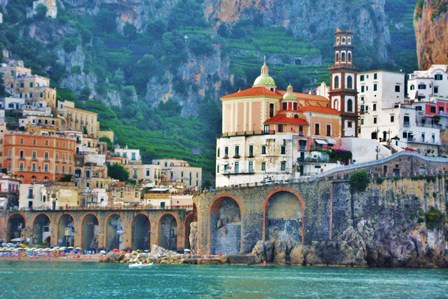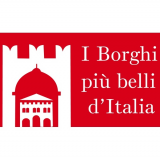
 I borghi più belli d'Italia
I borghi più belli d'Italia
Italian little Italies: Atrani, A Smiling Crescent of Houses on the Coast
- WTI Magazine #65 Jul 24, 2015
-

 I borghi più belli d'Italia
I borghi più belli d'Italia
WTI Magazine #65 2015 July, 24
Author : I borghi più belli d'Italia Translation by:
The beauty of Atrani lies in the choreography of the beach around it and the intricate maze of houses, built practically on top of each other, that make it look like a nativity scene, especially at night with the lights glimmering. In the daytime, the tiny streets sometimes seem to disappear behind the houses, only to reappear suddenly, widening into a small square, where the light of the sun can finally shine freely.
Very near to Amalfi, Atrani is the coastal village that has best preserved its original medieval structure of narrow streets, arches, courtyards, small squares, and the typical scalinatelle, or stairways.
It has a small, sheltered, secluded beach, from which the "lampare" boats leave in the evening for night fishing. At night, the myriad lights of the lampare on the sea is the prettiest sight one will ever find of the Mediterranean.
For such a small place, there are many things to see. This is because during the time of the Maritime Republics, Atrani was the residence of the noble families of Amalfi. This is where the Doges were crowned and buried.
A tour of the village must therefore begin with the Church of San Salvatore de Birecto, where the coronation of the highest government authority took place, with the solemn placing of the doge´s birecto, or cap, on his head.
Later remodeled in the neoclassical style, the church is actually very old, having been founded in 940. It contains a marble pluteus from the late 11th century with high reliefs in the Byzantine style and Lombard-influenced anthropomorphic figures. The handsome bronze doors were cast in Constantinople in 1087, commissioned by the noble Pantaleone Viaretta, who twenty years earlier had provided Amalfi with the doors of its Cathedral. The doors of the two churches are very similar, and those of Atrani are composed of 24 panels, with the four central panels richly inlaid with silver, copper and enamel, done using a Persian-Syrian technique.
Standing on the slopes of the mountain is the collegiate church of Santa Maria Maddalena, built in the 13th century by the people of Atrani in thanks to the Madonna for having saved them from the Saracen marauders. It has a single rectangular room, covered by a barrel vault and lit by two large Baroque windows. The façade is also Baroque. The small sacristy holds a white marble Roman cinerary urn. The glazed tile dome and square bell tower have become the symbol of the Atrani skyline.
Next to the church is Masaniello´s Cave, and below it is the home where Masaniello, the popular revolutionary leader, was born, built at the top of a flight of 500 steps.
A little ways above the old public road that links Atrani and Amalfi is the Cave of the Saints. It was probably part of the old Benedictine monastery of Saints Quirico and Judith founded in 986 by the future archbishop Leo I. The entrance to the small cave, which opens onto a terraced lemon grove, is enclosed by one of the arches supporting a water channel. The Cave´s perimeter is an irregular quadrilateral, and the walls are decorated with Byzantine-style frescoes from the 12th depicting the four evangelists. In the green background there is a warrior saint, undoubtedly St. George.
The name
The origin of the name is uncertain: most scholars are inclined to believe it comes from the Latin adjective ater - dark, obscure - because it would correspond to the view of the village as a dark spot enclosed by steep walls of rock looming over the sea.
Others claim the name derives from Atria, the settlement from which the first Greek colonists came.
The product
The cuisine of Atrani is generally that of Naples, largely based on fish and seafood and with old recipes handed down from mother to daughter.
Besides fish, other staple foods are fresh cheeses from the hills (mozzarella, fior di latte, provola), fresh cherry tomatoes "a piennolo," i.e. in bunches on the stem that keep until winter, and handmade pasta such as scialatelli and laganelle.
Delicious sweets in Atrani include o´ bocconotto, so good with custard and wild cherries that you eat it in just one bite, o´ pasticciotto, which is the Pantagruelian version, cassata, and sweets made with lemon, which here is called "sfusato amalfitano" and is without a doubt the finest in the entire Mediterranean area.
Atrani is also known for its liqueurs made from old farmer´s recipes, such as the famous limoncello as well as nocino, or nocillo (from walnuts), fragolino (strawberries), mortello, concerto, finocchietto (fennel), and lauro (bay leaf), delicious aromas that recall the days of 18th century parlours.
Not to mention treats such as passolini, sun-dried raisins wrapped in lemon leaves tied with rush twine; or fichi a crocetta, figs in wicker baskets flavored with spices, eaten at Christmastime.
The recipe
Our pick from among many possible choices is o´ sarchiapone, the green squash upon which this typical local dish is based.
A large squash is emptied, and the inside is cut into pieces and put into a baking dish with salt to draw out the water. The pieces are dried with a cloth, fried, and mixed with ground meat. This mixture is then sautéed in a pan with onions. Mozzarella, parmesan, pepper and salt (and, optionally, also hard-boiled eggs, salami, and ricotta) are then added to the mixture, which is then used to fill the emptied squash shell. The filling is covered with a meat tomato sauce (ragù), and the squash is baked in a medium oven for 20-30 minutes.
Sarchiapone is best accompanied by a dry, full-bodied red wine such as Furore or Tramonti.